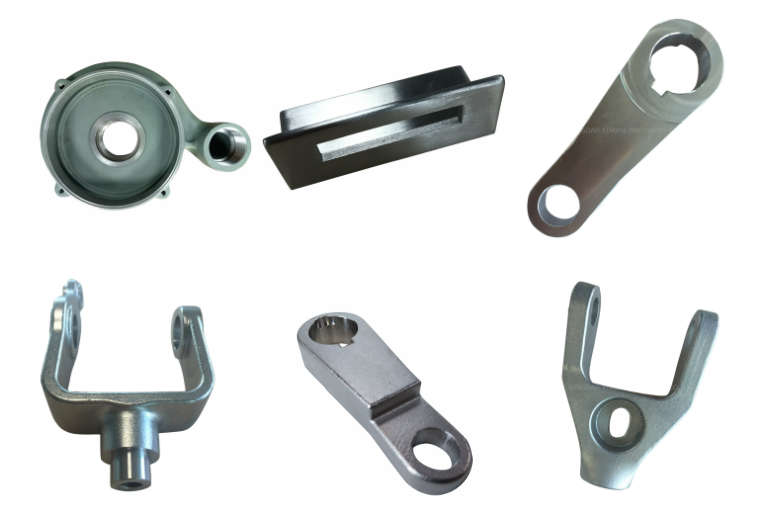Low Alloy Steel: Properties, Uses, and Advantages
Low alloy steel is a type of steel that contains small amounts of alloying elements, typically less than 5% by weight. These alloying elements are added to improve the mechanical properties of the steel, such as its strength, toughness, and hardness. Low alloy steel is commonly used in a variety of applications, including construction, automotive, and aerospace industries.
One of the main advantages of low alloy steel is its improved mechanical properties compared to standard carbon steel. By adding small amounts of alloying elements, the steel can be made stronger, more durable, and more resistant to wear and tear. This makes low alloy steel an ideal material for use in high-stress applications, such as heavy machinery or structural components.
Another benefit of low alloy steel is its cost-effectiveness. While it may be more expensive than standard carbon steel, the improved properties can often offset the higher cost. Additionally, low alloy steel can be heat-treated to further improve its mechanical properties, making it a versatile and reliable material for a wide range of applications.
Definition of Low Alloy Steel
Low alloy steel is a type of steel that contains a small amount of alloying elements (less than 5% by weight) that improve its mechanical properties compared to carbon steel. The alloying elements are typically added to improve the strength, toughness, and wear resistance of the steel.
The most common alloying elements used in low alloy steel include manganese, nickel, chromium, molybdenum, vanadium, and silicon. These elements are added in varying amounts and combinations depending on the desired properties of the steel.
Low alloy steel is often used in applications where high strength and toughness are required, such as in the construction of bridges, buildings, and heavy machinery. It is also used in the manufacturing of pipelines, pressure vessels, and offshore drilling platforms.
Compared to carbon steel, low alloy steel has a higher yield strength, tensile strength, and hardness. It also has better corrosion resistance and can withstand higher temperatures. However, it is more expensive to produce and may require special welding or heat treatment processes.
Overall, low alloy steel is a versatile and reliable material that offers improved mechanical properties over carbon steel. Its use in various industries and applications continues to grow as technology advances and new alloying elements are discovered.
What Is Low Alloy Steel?
In general, there are two categories of steel:
- Low alloy steel
- Stainless steel (or high-alloy steel)
Low alloy steel has low percentages of alloying elements such as chromium and nickel compared to stainless steel. As a result, low alloy steel does not have the heat, wear, or corrosion resistance provided by stainless steel. However, low alloy steel provides exceptional mechanical properties and a relatively low cost which makes it desirable for numerous customer applications.
The sections below detail why low alloy steel should be used and describe a few of the applications where MetalTek uses low alloy steel to manufacture components for its customers.
Why Use Low Alloy Steel?
Specific advantages provided by low alloy steel are:
- Low cost
- High strength
- Versatile mechanical properties
- Good weldability
Common examples of low alloy steel are:
- 4130 low alloy steel
- 4140 low alloy steel
- 4340 low alloy steel
Each of these (in addition to other low alloy steel) have the cost, strength, mechanical property, and weldability advantages described in detail below.
Low Cost
Because of the fewer alloying elements, low alloy steel such as 8620 has a lower cost and higher strength compared to stainless steel alloys such as MTEK 625 or MTEK 25-35. These stainless alloys, with higher chromium and nickel, achieve corrosion and heat resistance, but have a higher overall cost than low alloy steel. Low alloy steel can be a great choice for applications where cost savings and physical properties such as high strength are more critical than heat or corrosion resistance.
High Strength, Low Alloy Steel (HSLA)
Another advantage that low alloy steel has is strength. Low alloy steel can provide outstanding strength, even stronger than many high-strength martensitic stainless steel such as MTEK m-152 (which also provides excellent corrosion resistance). This can make low alloy steel ideal for high strength applications where properties such as corrosion resistance are not critical.
Properties of Low Alloy Steel
Mechanical Properties
Low alloy steel has a number of desirable mechanical properties that make it an attractive material for a variety of applications. One of the most important of these properties is its high strength-to-weight ratio. This means that low alloy steel is able to withstand high stress and strain without becoming deformed or damaged.
Another important mechanical property of low alloy steel is its high toughness. This means that it is able to absorb energy and resist fracture even when subjected to high impact loads. This makes it an ideal material for use in applications where impact resistance is important, such as in the construction of bridges and other structures.
Chemical Properties
Low alloy steel is also known for its excellent corrosion resistance. This is due to the fact that it contains a small amount of alloying elements, such as chromium, molybdenum, and nickel, which help to protect the steel from corrosion.
In addition to its corrosion resistance, low alloy steel is also highly resistant to wear and tear. This is due to its high hardness and toughness, which allow it to resist deformation and damage even when subjected to high levels of wear and tear.
Overall, low alloy steel is a highly versatile and reliable material that offers a number of important mechanical and chemical properties. Whether used in the construction of buildings, bridges, or other structures, or in the manufacture of machinery and equipment, low alloy steel is an excellent choice for a wide range of applications.
Types of Low Alloy Steel
High Strength Low Alloy Steel
High Strength Low Alloy Steel (HSLA) is a type of low alloy steel that has a higher strength-to-weight ratio than conventional low carbon steel. HSLA steels are commonly used in structural applications, such as bridges, buildings, and offshore platforms. The addition of small amounts of alloying elements, such as vanadium, niobium, or titanium, improves the strength and toughness of the steel.
HSLA steels are divided into two categories: weathering and non-weathering. Weathering HSLA steels contain copper, nickel, and chromium, which form a protective oxide layer that resists corrosion. Non-weathering HSLA steels do not contain these elements and are not suitable for outdoor applications.
Low Alloy Steel with Improved Corrosion Resistance
Low Alloy Steel with Improved Corrosion Resistance is a type of low alloy steel that contains a higher percentage of alloying elements, such as chromium, nickel, or molybdenum. These elements improve the corrosion resistance of the steel and make it suitable for use in harsh environments, such as chemical plants, oil refineries, and marine applications.
The most common type of low alloy steel with improved corrosion resistance is stainless steel, which contains at least 10.5% chromium. Stainless steel is highly resistant to corrosion and staining and is used in a wide range of applications, such as kitchen appliances, medical equipment, and aerospace components.
Low Alloy Steel with Improved Toughness
Low Alloy Steel with Improved Toughness is a type of low alloy steel that has improved toughness and impact resistance. This is achieved by adding alloying elements, such as manganese, silicon, or nickel, which improve the steel’s ability to absorb energy without fracturing.
Low Alloy Steel with Improved Toughness is commonly used in applications that require high strength and toughness, such as pressure vessels, pipelines, and heavy machinery. The most common type of low alloy steel with improved toughness is quenched and tempered steel, which is heat-treated to improve its strength and toughness.
In conclusion, Low Alloy Steel is a versatile material that can be tailored to meet specific requirements by adjusting the alloying elements. High Strength Low Alloy Steel, Low Alloy Steel with Improved Corrosion Resistance, and Low Alloy Steel with Improved Toughness are three common types of low alloy steel that are used in a variety of applications.
Applications of Low Alloy Steel
Construction Industry
Low alloy steel is used extensively in the construction industry due to its high strength and durability. Low alloy steel is often used in the construction of bridges, buildings, and other large structures. The steel’s high strength-to-weight ratio allows for the construction of large structures that can withstand high loads and stresses.
Automotive Industry
Low alloy steel is also used in the automotive industry due to its high strength and good weldability. The steel is used in the construction of car bodies, chassis, and other structural components. Low alloy steel is also used in the production of engine components such as crankshafts and connecting rods.
Oil and Gas Industry
Low alloy steel is widely used in the oil and gas industry due to its high strength and resistance to corrosion. The steel is used in the construction of pipelines, drilling rigs, and other equipment used in the extraction and transportation of oil and gas. Low alloy steel is also used in the construction of storage tanks and other equipment used in the processing of oil and gas.
Low alloy steel is a versatile material that finds applications in many industries. Its high strength, durability, and resistance to corrosion make it an ideal material for use in construction, automotive, and oil and gas industries.
There are prominent examples where the low cost, high strength, versatile mechanical properties, and high weldability of low alloy steel make it ideal for specific customer applications:
- Power generation: MetalTek centrifugally casts engine cases for land-based turbine engine applications in a low alloy steel (MetalTek grade WC 6).
- Defense: MetalTek produces centrifugally cast and investment cast components for a proprietary artillery application for the U.S. military. The low alloy steel used for this application provides excellent strength as well as good weldability with other components in the complete assembly.
- Mining: Hydraulic cylinders made from MTEK 8630 require excellent strength to help support mining dump trucks, which can weigh hundreds of tons when fully loaded.
Low Alloy Steel: Conclusions
Low alloy steel has advantages that make it ideal for a range of customer applications where high strength and low cost are paramount. Hengke Metal has practical expertise in over 450 ferrous and non-ferrous alloys, including proprietary grades. This expertise allows customers to choose alloys that meet the most demanding product requirements. Contact us to learn more.

